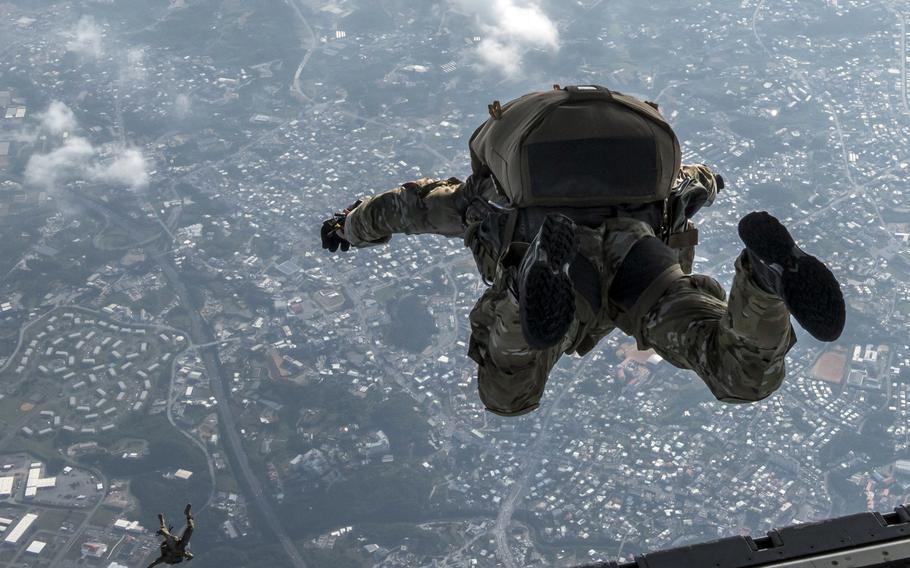
U.S. airmen and soldiers parachute off an MC-130J Commando II above Kadena Air Base, Okinawa, April 24, 2017. (John Linzmeier/U.S. Air Force)
Okinawa’s governor has asked for a halt to parachute training at the Air Force base on the prefecture’s main island and for a range of other measures aimed at curbing the impact of U.S. forces stationed there.
“Parachute training should not be conducted at Kadena Air Base,” Gov. Denny Tamaki wrote in a letter to Japanese Prime Minister Fumio Kishida and other members of his cabinet that was posted Tuesday on the Okinawa prefecture’s official website.
Kadena is home to the Air Force’s 18th Wing and numerous aircraft, including fighter jets, cargo planes, helicopters and drones.
Parachute training should happen outside of Okinawa or abroad until the completion of runway maintenance at Ie Shima, a 9-square-mile island northwest of the main island, Tamaki wrote in his letter.
Ministry officials responded that parachute training must take place regularly, a spokeswoman for the prefecture’s Military Base Affairs Division told Stars and Stripes by phone Tuesday. Some Japanese government officials may speak to the press only on condition of anonymity.
“Troops conducting parachute training at Kadena are responsible for emergency deployments and search and rescue missions, which require a high level of readiness,” said a ministry statement provided by the division spokeswoman.
“As the Ministry of Defense, we have no intention of requesting the U.S. to halt this training,” the statement said.
The 18th Wing, in an unsigned statement emailed Monday to Stars and Stripes, said Ie Shima Auxiliary Airfield, managed by the III Marine Expeditionary Force, remains the U.S. military’s primary drop zone in the prefecture.
The Ridout drop zone at Kadena is an alternate location, the statement said.
“Relying solely on Ie Shima for jump training is insufficient for meeting our team’s requirements, which impacts our readiness to meet our treaty obligation to support the defense of Japan,” the statement said.
“Factors at Ie Shima, to include weather, winds, sea state, airfield conditions and other potential factors cause exceptional circumstances that will drive 18th Wing to occasionally use RIDOUT in accordance with bilateral agreements to ensure our readiness.”
Since December the wing has conducted jump operations at Ridout about once a month due to enduring exceptional conditions at Ie Shima, the wing said.
“In that same time, more than half of Kadena-based personnel jumps have occurred outside of Japan during off-station training opportunities,” the statement said. “All RIDOUT DZ jumps occur in full accordance with bi-lateral agreements, based on critical training requirements that ensure the defense of Japan.”
Tamaki’s letter made other requests, including limits to the number of foreign aircraft visiting Kadena and strict measures to limit base noise and to prevent aircraft flying over homes and at night.
Officials should reconsider the deployment of Air Force MQ-9 Reaper drones to Kadena, he wrote of the aircraft that arrived at the base late last year.
Sites on base should be sampled for PFOS and an investigation begun on the origin of the contaminants, Tamaki wrote in his letter, which marks the sixth time he has complained about the U.S. military presence this year.
PFOS is a component of PFAS, short for poly and perfluoroalkyl substances, a class of chemicals linked to an increased risk of certain tumors of the liver, testicles, breasts and pancreas, according to the American Cancer Society.
The U.S. Environmental Protection Agency updated its health advisories last year to say no level of PFAS chemicals, which include PFOS and PFOA, is safe in drinking water.